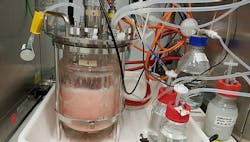Carbon Dioxide Underpins Microbial Route To Feedstocks
A combination of heterogenous chemical catalysis, electrochemistry and metabolic engineering pioneered by German researchers has created potentially unlimited uses for carbon dioxide (CO2) as a raw material in chemical manufacturing.
The researchers, based at the Fraunhofer Institute for Interfacial Engineering and Biotechnology IGB, Stuttgart, use a catalytic step to convert CO2 to methanol and an electrochemical step to transform CO2 to formic acid.
What’s new here is the methanol and formic acid then serve as nutrients for engineered microorganisms which can produce organic acids used in polymer manufacture and amino acids employed in food supplements and animal feed (Figure 1).
“In principle, the product spectrum is unlimited. Due to the use of synthetic biology and metabolic engineering within the cell, a vast amount of chemical products can be derived from the intracellular metabolites of such engineered microbes,” says Jonathan Fabarius, senior scientist biocatalysts at Fraunhofer IGB.
The team chose methanol and formic acid because they are comparably straightforward to produce via chemical and electrochemical processes. Some bacteria such as methylotrophic strains can metabolize these liquid substrates naturally, notes Fabarius. However, metabolic engineering still is required to improve their production capacities, he stresses.
“Moreover, liquid substrates provide advantages regarding high solubility in aqueous solution, which circumvent mass-transfer limitations faced in gas fermentation, for example with syngas fermentation or direct CO2 conversion by algae,” he adds.
On the catalysis side, the researchers currently are working on two fronts: first, to increase catalyst stability and resilience under flexible-load operating conditions and against possible contaminants of CO2 from “real” sources such as industrial exhaust gases; and second, to enhance process selectivity and, thus, yields and efficiency through development and engineering of catalyst materials and process conditions.
They have achieved 10-L-scale production of a natural terpenoid dye from a methylotrophic bacterium and are working to get organic acids and amino acids to the same scale.
“We are highly interested to further develop these processes to pilot scale and beyond, both for and in collaboration with interested industrial partners. At Fraunhofer IGB, we have the expertise and infrastructure for the scale-up of biotechnological processes up to 10-m3 reactor volume,” states Fabarius.
However, achieving this requires overcoming two big challenges: the toxicity of CO2-derived formic acid to bacterial cells, and the flammability of methanol.
“These challenges must be solved with advanced engineering efforts regarding fermentation, for example feeding strategy, and explosion protection — or with enhanced metabolic engineering studies to improve biocatalyst stability against toxic substrate,” he concludes.
